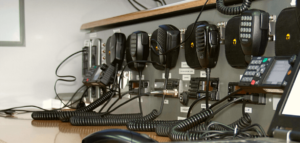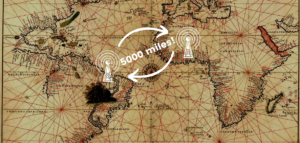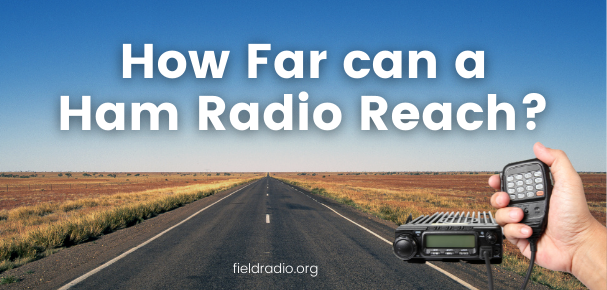Radio communication is a critical life skill. Yes, even today.
Your smartphone and internet are only one major disaster away from abandoning you. Radio, however, is much more resilient and it takes more than just a bunch of hurricanes and tornadoes to take them out.
Many people understand this and want to learn radio skills to help them during emergencies. But a difficult decision faces them as they stand on the threshold of the radio world.
Should they buy a GMRS or a Ham radio?
Both GMRS and Ham radios are popular for their emergency services. And to make things more confusing, both share a number of similarities.
But where there are similarities, there are differences as well.
In this article, I’ll talk about these differences to make choosing between a Ham and a GMRS radio easier for you.

GMRS operates on 22 fixed channels along the UHF spectrum while Ham radio operates on many frequencies in the HF, UHF, and VHF ranges. Additionally, acquiring a GMRS license is much easier then getting a Ham radio license. Also, GMRS does not have the same learning curve as that of Ham radio.
GMRS vs. Ham Radio – Frequencies
The most important difference between the two types of radios is that of frequencies.
GMRS operates only on the UHF spectrum on 22 pre-programmed channels that lie between 462 to 467 MHz.
On the other hand, Ham radio operates on three spectrums, namely the HF, VHF, and UHF spectrums, on numerous sets of frequencies, called bands. Each band has a range of frequencies, and depending on your license class, you can tune in to any frequency you want and use it.
Purpose of Use
Another important area where Ham and GMRS radios differ is the purpose of use.
Ham radio is mostly used by passionate hobbyists who live and breathe amateur radio. Besides its hobbyist use, Ham radio also finds important applications in emergency situations.
Since it operates on lower frequencies and has relatively stable signals, Ham radio is known to be a reliable means of communication during and after calamities.
GMRS often finds two simple applications. It is used to maintain communications between families during adventure trips or emergencies.
A GMRS radio is also relied upon when someone is entering the radio world and wants to “test the waters” before going all in.
Ease of Use
Ham and GMRS radios differ wildly regarding ease of use, so considering this factor is critical when deciding which one to invest in.
GMRS is hands-down the easiest to use. You can start transmitting from it right out of the box if you have your license.
Ham radio is much more complicated than GMRS. You need to study a lot of technical stuff and pass an exam before you can even start transmitting.
There are a lot of technicalities involved in setting up and getting the most out of Ham radio, which is why the people who manage to go deep into it are the ones that have a special affinity with physics, math, and propagation theory.
This is why GMRS is the go-to choice for newbies who want to benefit from radio communications without getting bogged down with all the geeky tech stuff.
Types of People Who Use Them
Ham radio has a very distinct, often stereotyped community. So it is important to talk about the people who use each type of radio.
The Ham radio community comprises tech geeks who are passionate about their radios and love talking to random strangers who also happen to have an amateur radio.
Hams also often volunteer their services during emergencies and help maintain connections when communications are down.
GMRS users are mostly families only looking for a reliable alternative to smartphones for fun or to stay connected when phone signals are out.
Another class of GMRS users includes people trying to ease their way into the radio world and are starting with something simpler before they can scale up to something as advanced as Ham radio.
Licenses
GMRS licensing is simple. You go online, register, pay the fee, and get your callsign.
The GMRS license is also valid for the entire family. If you get your license, all your family members can use the radio.
Ham radio licensing procedure is a tad more complex.
There are three classes of Ham radio license – the technician class, advance, and extra class. And you have to pass a separate exam for each license class.
Moreover, you are not allowed to respond to a Ham signal transmitted from an unlicensed station.
Therefore, if you want to use a radio to stay in touch with the family during emergencies, all your family members will need individual licenses. And convincing them to get licensed might be a challenge for some people.
Also, just so you know, a Ham Radio Licence may not give you the permission to transmit from a Ham Radio on GMRS, and vice versa.
Equipment Details
The type of equipment used in each type of radio depends on what you want to use the radio for.
GMRS is mostly used for simple communications; hence, a handy-talky suffices for most people.
But people using GMRS as an entry point into the radio world invest in bigger equipment like transceivers, antennas, and adapters, but that’s about it.
Ham radio equipment also varies depending on the use case, and for some people, a simple HT such as Baofeng might be enough.
But for most Hams, the basic equipment needed for Ham radio operation would include a transceiver/radio with a microphone, antenna, antenna tuners, power supply, cables, etc.
Distance and Range
The range of a radio depends on many variables, including transmission power and frequency, propagation conditions, antenna, and more.
The transmission power on GMRS is restricted to 50 watts max. Additionally, high-frequency waves tend to have a lower range, and GMRS operates on the high-frequency UHF spectrum.
The low power and high frequency significantly limit the range of GMRS radios. Therefore, they can only be used for line-of-sight communications.
Ham radio can transmit up to 1500 watts of power and operates on lower frequencies in the HF and VHF spectrums as well. Therefore,
Ham radios can have a wider range when operating in these spectrums.
A Ham radio, when transmitting on high power and HF spectrum, can reach stations thousands of miles away.
The longest known Ham radio contact is between South America and Africa at a distance of around 5000 miles.

So, Which one is Better?
Choosing between a Ham and GMRS radio depends on your intended use and willingness to learn.
A GMRS might be good for you if you want to keep your distance from the geeky stuff, don’t want to convince your family to get licensed, and have a simple device for short-range, two-way communications.
But if you are enthusiastic about learning radio communications and are willing to dive deep into the technicalities of radio, Ham radio might be a good choice.
In case you are still unable to decide, why not get both? A GMRS might come in handy when talking to your family, and a Ham to help you connect with your local Ham radio community.

I have been passionate about the world of communications in its various forms for most of my life. Ever since I first found an old ham radio stashed away in my uncle’s attic, I have had a fascination with this classic technology.
Having the ability to communicate with people without the need to rely on telephone lines or networks is an empowering feeling which I believe everyone should have at least a basic knowledge of. Becuase who knows when you might need it?
I setup fieldradio.org with this passion in mind, to help inform people about the amazing possibilities of amateur radio and I’m on a quest to help educate as many budding operators as possible.
I hope you enjoy our content. Come and say hi, via our contact form


